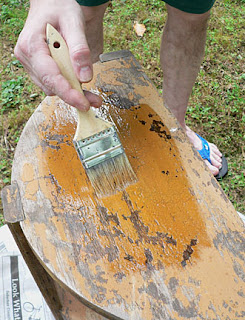 QUESTION: I recently purchased a beautiful old armchair from a consignment shop. It looks a lot like a Philadelphia Chippendale chair but I can’t be sure. Also, how do I determine the value? Can you help me?
QUESTION: I recently purchased a beautiful old armchair from a consignment shop. It looks a lot like a Philadelphia Chippendale chair but I can’t be sure. Also, how do I determine the value? Can you help me?ANSWER: This is a common question. Since the Antiques Roadshow first appeared on the air on PBS, people have been obsessed with knowing the value of their belongings. In fact, that’s the first question most people ask, not what is it or how old is it?
In the case of this chair, knowing what it is and how old it is makes all the difference in its value. Looking closely, you’ll notice that the carving on the knees of the chair is rather shallow. That tells you that this chair was made in a factory and not by hand in a cabinetmaker’s workshop the way authentic 18th-century Chippendale chairs would have been made. Also, the wood is dark-stained to look like mahogany. In Colonial times, cabinetmakers would have used real mahogany wood and then given it several coats of varnish to bring out the smooth surface shine.
 This chair is most likely from the early part of the 20th century and not even 100 years old, so technically it isn’t an antique. As a used pieced of furniture, its value will depend on what the buyer wants to pay for it.
This chair is most likely from the early part of the 20th century and not even 100 years old, so technically it isn’t an antique. As a used pieced of furniture, its value will depend on what the buyer wants to pay for it. While the answer to the question of value may seem simple, in fact, it’s far from it. What type of value–retail value, insurance replacement value, fair-market value, auction value, or cash value? In the end, each of these values will be a different amount. Other factors determining value are age and condition. So where to begin.
Let’s start with retail value. This is the price for which an antiques dealer expects to sell an item after marking it up from the price the dealer paid for it in order to make a profit. This amount can be anywhere from 20 to100 percent of the dealer’s purchase price.
The amount of money it would take to replace an item from a antiques shop or online if it were lost, stolen, or damaged is called the insurance replacement value.
 The price that an item would sell for on the open market between a willing buyer and a willing seller is known as the fair-market value. This is also the value that’s used when an item is donated to a charity or is part of someone’s estate.
The price that an item would sell for on the open market between a willing buyer and a willing seller is known as the fair-market value. This is also the value that’s used when an item is donated to a charity or is part of someone’s estate.And when someone puts an item up for auction, the price that an appraiser feels the item should bring at auction, based on comparison of like items and recent other auction sales, is known as the auction value, but has nothing do with the actual value of the item.
However, being told something is worth a specific value is meaningless if the appraiser doing the appraisal has no knowledge of the item itself or the market for it. And auction prices, such as those eBay are not an indicator of true "worth," since many of these sales prices are inflated many times over in the heat of bidding up an item. And a verbal appraisal is worth nothing without a written appraisal to back it up, especially in the case of settling an estate. Only a written appraisal is legally binding in case of damage or loss.
To learn more about how to value your antiques and collectibles, read my article, “What’s It Worth?,” in The Antiques Almanac.



















